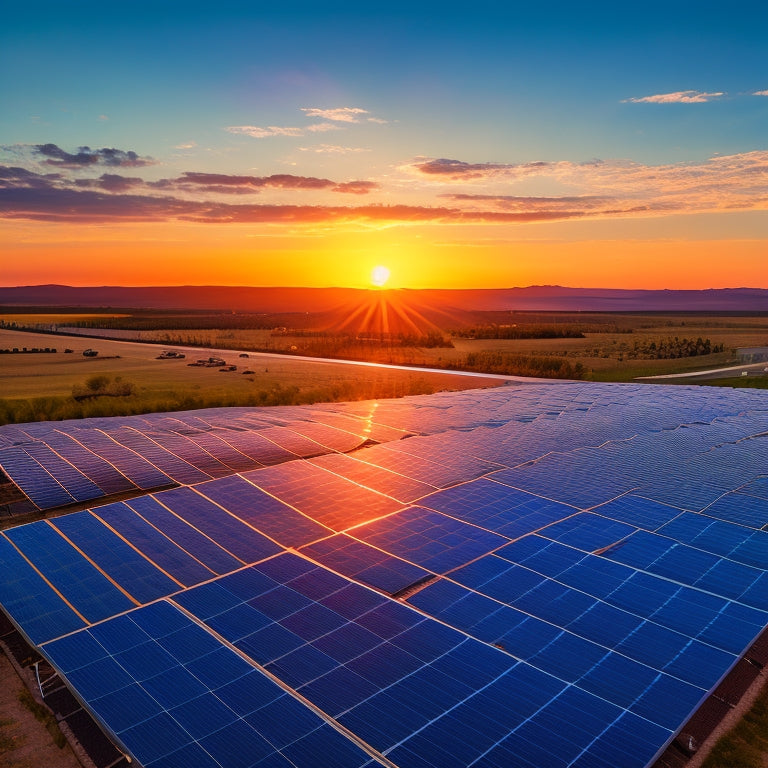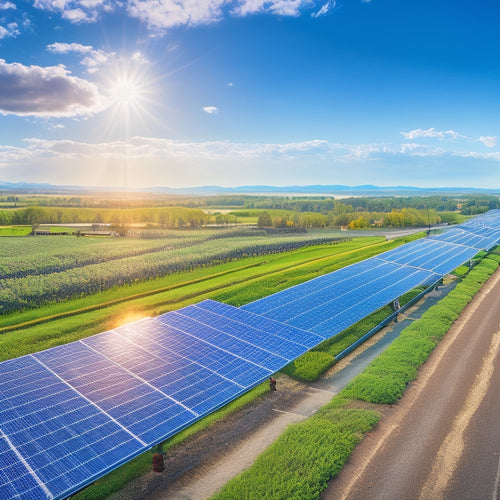
Large Solar Panels
Share
When it comes to large solar panels, you're likely looking to maximize energy output in a limited space. Peak sunlight hours, ideal exposure, and high-efficiency systems yield higher energy production. Larger panels can greatly impact your carbon offset potential, reducing your environmental footprint. With advancements in bifacial cell design, you can capture energy from both sides, increasing overall output. High-energy density panels optimize power generation, and fewer maintenance requirements mean lower costs. As you investigate the benefits of large solar panels, you'll unveil how to optimize your investment and create a more sustainable future – and there's more to reveal about how these panels can alter your energy strategy.
The Essentials
- Large solar panels offer higher energy production and efficiency, especially during peak sunlight hours, making them ideal for maximum power output.
- Bifacial cell design in large solar panels captures energy from both sides, increasing overall energy output and reducing environmental impact.
- Energy storage solutions are essential for large solar panels to store excess energy for nighttime or low sunlight use, reducing grid reliance.
- Larger solar panels require fewer maintenance visits, have lower mechanical failure rates, and longer lifespans, making them a cost-effective option.
- High-efficiency large solar panels yield higher energy output in smaller spaces, making them ideal for urban areas or those with limited installation space.
High Energy per Hour
You'll find that peak sunlight hours have a significant impact on your solar panel's energy production. When your panels are exposed to ideal sunlight, they're capable of reaching their maximum power output.
This is why understanding the relationship between peak sunlight hours and maximum power output is essential for maximizing your energy per hour.
In fact, high-efficiency solar panel systems can provide a higher energy output per panel, allowing homeowners to generate more power in smaller spaces.
Peak Sunlight Hours Matter
Peak sunlight hours, the timeframes when the sun's rays strike the Earth most directly, pack a notable punch regarding energy per hour. You'll want to optimize your solar panel's solar orientation to capture these peak hours, as they can greatly impact your energy output.
With a reliable solar energy storage system, you can utilize and store excess energy generated during peak sunlight hours for use during the night or on cloudy days. Additionally, understanding peak sunlight hours is vital for reducing grid dependence and achieving greater energy independence.
During peak sunlight hours, the sun's rays are most concentrated, resulting in higher energy production per hour. This is especially important if you're looking to maximize your energy independence.
You'll want to evaluate your location's weather impact, such as cloud cover and shading, which can reduce the number of peak sunlight hours available. In areas with minimal weather impact, you can expect more consistent peak sunlight hours, resulting in higher energy production.
Maximum Power Output
As the sun's rays strike your solar panels during peak sunlight hours, they're capable of generating a maximum power output that's considerably higher than during other times of the day.
This maximum power output is a critical factor in determining the overall energy production of your solar panel system. With advancements in panel technology, solar efficiency has improved, allowing you to utilize more energy per hour.
However, installation considerations, such as panel angle and shading, can impact your system's ability to reach its maximum power output.
By integrating a reliable home battery storage solution, you can guarantee that excess energy is stored for later use, optimizing your energy consumption and reducing reliance on the grid.
Additionally, incorporating energy storage solutions, such as batteries, can help you store excess energy generated during peak hours for later use.
Increased Carbon Offset Potential
As you consider large solar panels, you'll find that their increased energy production directly correlates with enhanced carbon reduction efforts.
By deploying these panels, you'll be able to implement emissions decrease strategies that make a significant impact. With a larger carbon offset potential, you can effectively mitigate your organization's environmental footprint.
Additionally, incorporating renewable energy solutions into your home can lead to substantial long-term savings on energy bills, while also contributing to a cleaner environment.
Carbon Reduction Efforts
Many large-scale solar panel installations are being designed with carbon reduction efforts in mind, offering a significant increase in carbon offset potential.
As you consider investing in solar energy, you'll want to understand how these installations can benefit the environment. The solar panel benefits are clear: they reduce your reliance on fossil fuels, decrease your carbon footprint, and contribute to a cleaner, healthier planet.
By utilizing the power of the sun, you'll be producing clean energy that doesn't emit harmful greenhouse gases. This, in turn, reduces the overall carbon footprint of your operation, helping to combat climate change.
Additionally, large-scale solar panel installations can offset a substantial amount of carbon emissions, making them an attractive option for organizations and individuals committed to sustainability.
Emissions Decrease Strategies
Several large-scale solar panel installations are employing innovative emissions decrease strategies to maximize their carbon offset potential. As you investigate these installations, you'll notice they're leveraging solar policy and renewable incentives to drive growth.
Effective grid integration is vital, ensuring a seamless shift to renewable energy sources. Energy storage solutions, like batteries, are also being implemented to stabilize the grid and reduce emissions.
You'll find that investment strategies focused on technological advancements, such as bifacial panels and tracking systems, are yielding significant environmental impact reductions. Community engagement is also essential, as it cultivates support for large-scale solar projects and promotes a culture of sustainability.
Lifecycle assessments are being conducted to identify areas for improvement, and market trends are being monitored to stay ahead of the curve. By adopting these emissions decrease strategies, you can maximize carbon offset potential and contribute to a cleaner, freer future.
As you traverse the world of large solar panels, remember that every incremental gain in efficiency and sustainability brings us closer to a world powered by renewable energy.
Efficient Bifacial Cell Design
You're likely familiar with traditional solar panels that utilize energy from one side.
However, bifacial cells take it to the next level by capturing energy from both the front and back sides, resulting in increased energy output.
Dual-Side Energy Harvesting
Utilizing energy from both the front and back sides of a solar panel can considerably enhance its overall energy output. This dual-side energy harvesting technology, also known as bifacial technology, allows you to capitalize on the energy reflected from the ground or surrounding environment onto the back side of the panel. By optimizing solar panel orientation, you can increase energy production while reducing the environmental impact of your installation.
| Benefits | Description |
|---|---|
| Cost Efficiency | Reduced installation costs due to increased energy output from the same surface area |
| System Scalability | Easier integration into existing grid infrastructure |
| Performance Monitoring | Enhanced monitoring capabilities to optimize energy production |
When implementing dual-side energy harvesting, it is crucial to take into account factors such as energy storage, installation techniques, and market trends. By doing so, you can maximize the benefits of this technology, including increased energy output, reduced costs, and a lower environmental footprint. As you examine the potential of large solar panels, keep in mind that dual-side energy harvesting can be a transformative factor for your energy independence.
Maximizing Energy Output
Optimizing bifacial cell design is critical for maximizing energy output in large solar panels. You need to take into account the solar panel orientation to guarantee that your bifacial cells are positioned to capture the most energy from both the front and back sides. The ideal orientation will depend on the specific installation site and the surrounding environment.
In addition to optimizing the solar panel orientation, you should also take into account the energy storage system that will be used to store excess energy generated during the day for use at night or during periods of low sunlight. This will help to secure a stable and reliable energy supply.
Wattage per Square Foot
You'll find that energy density matters appreciably when it comes to large solar panels, as it directly impacts the wattage per square foot.
By leveraging renewable energy solutions and optimizing energy efficiency, you can reduce your reliance on traditional power sources and lower your electricity bills.
A higher power output ratio is essential, as it enables you to generate more electricity from a given surface area.
Energy Density Matters
How much power can a solar panel really pack into a given space? This is where energy density matters. As you consider large solar panels, you want to maximize the wattage per square foot to optimize your renewable energy investment.
Solar panel efficiency plays an essential role in achieving this goal. With advancements in solar technology, modern panels can generate more power from the same surface area, making them a more attractive option for those embracing sustainable energy practices.
As the solar market grows, energy storage solutions and grid integration strategies become increasingly important. You'll want to design a photovoltaic system that not only generates power but also stores excess energy for later use.
This is where energy density comes into play, as it directly impacts the overall efficiency of your system. By prioritizing energy density, you'll be better equipped to maneuver energy policy impacts and capitalize on the environmental benefits of solar power.
Power Output Ratio
What's the key to unblocking the full potential of large solar panels? It's understanding the power output ratio, which refers to the wattage produced per square foot of solar panel surface area. This metric is vital in determining the efficiency of your solar panel installation.
When evaluating large solar panels, you'll want to take into account the power output ratio to guarantee you're getting the most bang for your buck. Here's a breakdown of the power output ratios for different solar panel sizes:
| Solar Panel Size (W) | Power Output Ratio (W/sqft) | Efficiency (%) |
|---|---|---|
| 300 | 15.6 | 19.4 |
| 350 | 17.2 | 20.5 |
| 400 | 19.1 | 22.1 |
| 450 | 20.9 | 23.5 |
| 500 | 22.7 | 24.9 |
As you can see, larger solar panels don't always translate to higher power output ratios. You'll need to evaluate the benefits of larger panels against installation challenges and cost factors. By doing so, you'll be able to optimize your solar panel installation for maximum energy production and freedom from fossil fuels.
Fewer Maintenance Requirements Needed
You'll find that larger solar panels require fewer maintenance visits, which means you'll need to repair or replace them less often.
This reduced repair frequency is due to the simplified design and fewer components, resulting in a lower likelihood of mechanical failure.
With fewer moving parts, you can expect a longer lifespan and reduced downtime for your solar panel system.
Reduced Repair Frequency Needed
With large solar panels, the likelihood of component failure decreases, resulting in fewer maintenance requirements needed. This means you'll spend less time and resources on repairs, giving you more freedom to focus on other aspects of your life.
The reduced repair frequency needed is attributed to the advanced technology and design of these large solar panels.
The repair longevity of large solar panels is noticeably longer compared to smaller ones. This is due to the reduced number of connections and joints, which are common failure points.
With fewer connections, the risk of failure is minimized, resulting in a longer lifespan for your solar panel system.
Maintenance innovations have also played a vital role in reducing repair frequency. Advanced monitoring systems and remote diagnostics enable you to detect potential issues before they become major problems.
This proactive approach to maintenance guarantees that your solar panel system operates at peak levels, with minimal downtime and reduced repair needs.
Frequently Asked Questions
What Is the Ideal Roof Size for Large Solar Panels?
When determining your ideal roof size, you'll want to contemplate solar panel orientation for best energy efficiency. Generally, a roof with at least 500-750 square feet of usable space is ideal, but this can vary depending on your energy needs and local building codes.
Can Large Solar Panels Be Used for Off-Grid Systems?
When you're seeking energy independence, you'll find that off-grid systems are a viable option; you can install solar panels, considering factors like roof size, orientation, and energy storage, to achieve self-sufficiency with careful installation considerations.
Are Large Solar Panels More Prone to Damage?
You're probably wondering if massive power generators are accident-prone time bombs waiting to self-destruct; fortunately, large panel durability is surprisingly sturdy, but environmental impact from manufacturing and installation can be a concern, so choose wisely.
Do Large Solar Panels Require Special Installation Equipment?
When you're handling solar panels, you'll find that they require special installation equipment, especially during the installation process, which involves complex mounting options, and you'll need to invest in customized gear to guarantee a secure and efficient setup.
Can Large Solar Panels Be Used for Residential Properties?
As you dream of energy independence, you wonder if residential properties can utilize the power of the sun; yes, they can, with large solar panels offering enhanced energy efficiency and significant cost savings, liberating you from grid reliance.
Final Thoughts
As you utilize the power of large solar panels, you're not just generating electricity - you're releasing a tidal wave of clean energy. With high energy per hour, increased carbon offset potential, and efficient bifacial cell design, these panels are the epitome of innovation. Plus, with more wattage per square foot and fewer maintenance requirements, you'll be riding the wave of sustainability in no time.
Related Posts
-

Top Eco-Friendly Camping Equipment for a Sustainable Adventure
When you're camping with the planet in mind, opt for eco-friendly gear like tents made from recycled materials and bi...
-

Smart Home Thermostats to Revolutionize Your Space
Smart home thermostats revolutionize your space by providing precise temperature control and optimizing energy saving...
-

Applications of Photovoltaic Systems
Photovoltaic systems are versatile, converting sunlight into electricity for various applications. You can use them i...


